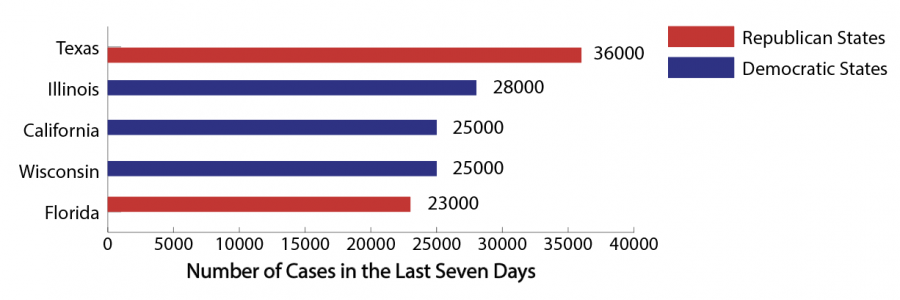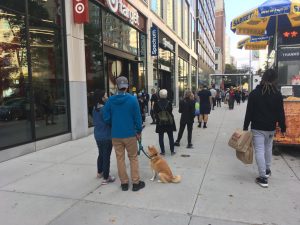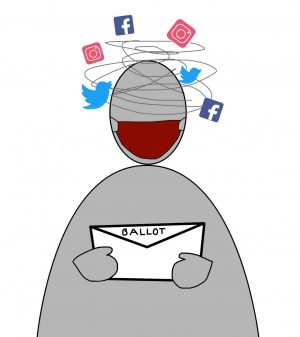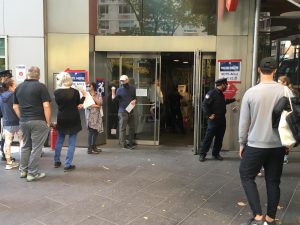Nationwide Surge in COVID-19 Cases Comes Just in Time for the Election
October 28, 2020
As Election Day draws nearer and the weather cools, the number of positive COVID-19 cases is once again increasing, bringing the U.S. to the cusp of a second wave.
As of Oct. 24, a total of 8.6 million cases and over 225,000 deaths nationwide have been reported by The New York Times. Additionally, a NBC news article stated that the nation has recently seen record single-day increases in new nationwide cases, with 77,640 cases on Oct. 22 and 79,303 on Oct. 23.
Areas of the U.S. where rates appear to have increased the most include the Midwest and rural West communities, with states like Wisconsin and Illinois reporting just over 25,000 and 28,000 cases, respectively, within the last seven days, according to the Centers for Disease Control and Prevention.
Communities in North and South Dakota are also experiencing record case increases at 61% and 40% in the past 14 days. Texas had almost 36,000 new cases in the past week, while California and Florida reported 25,000 and almost 23,000, respectively. New York City cases were reported at just over 5,600. Based on data from the NYC Health website, Manhattan specifically has reported almost 500 new cases, 34 hospitalizations and one death in the past seven days.
With no end to the pandemic in sight and a second wave on the way, the presidential candidates’ plans for combating the coronavirus continue to be a heavy topic of debate and discussion.
Colleges and universities across the country have also been hit significantly by COVID-19. Despite efforts to prevent further viral spread by utilizing distance learning methods and keeping campuses closed or depopulated, The Times has reported a total of over 207,000 cases since late July, of which over 35,000 have appeared since the beginning of October.
However, each institution has its own methods of testing students and tracking and reporting cases, as well as differing safety measures and guidelines between institutions. For example, Fordham University reporting runs on a 14-day system in which total tests and cases of both the Lincoln Center and Rose Hill campuses are updated to reflect data from the past two weeks. Because of the differing systems between institutions nationwide, the total case count among colleges and universities is likely lower than reports.
With no end to the pandemic in sight and a second wave on the way, the presidential candidates’ plans for combating the coronavirus continue to be a heavy topic of debate and discussion, especially during the final presidential debate on Oct. 22.
Former Vice President Joe Biden said he plans to start new shutdowns if scientists and professionals recommend it. Although it is not ideal to most of the public and for businesses like bars and gyms, Biden has emphasized that safety and proper precautions are necessary for ending this pandemic. In the last debate, he claimed that he will “shut down the virus, not the country.”
President Donald Trump, on the other hand, opposes another shutdown, favoring the idea of reopening businesses and schools as soon as possible and placing blame of slow reopenings on the Democratic Party. He argues that businesses are dying because of the pandemic and what is needed for the economy is a full-force reopening, despite expert scientific opinions discouraging that idea.
For the past six months, Trump has claimed that the pandemic will reach its end soon, that the country is “rounding the corner.” However, despite his plans to manufacture and distribute 300 million vaccines by January 2021, critics and experts say that America will still need to continue preventative measures such as wearing a mask and social distancing into 2022.
As early as mid-July, online medical journals and blogs have been discussing ways that Americans can prepare for this second wave. More recently, however, Hartford HealthCare published a short article about the 10 things people should have to get through the coming months. Among these items are humidifiers, air purifiers and “COVID-19 supplies,” like masks, disinfectant wipes, sanitizer and household cleaners. With the changing weather and the start of the flu season, it is even more important to stay healthy and take necessary precautions to lessen the likelihood of contracting other illnesses.
As the U.S. continues to climb in coronavirus cases, it is crucial for the public to continue practicing safety measures like mask-wearing, hand washing and social distancing. For college students living on campus, this is especially important due to the dense living conditions in college dormitories. Following the school’s safety measures and avoiding large group gatherings are key ways that students can prevent increasing cases and institution shutdowns. In the meantime, the public can only hope the candidates’ plans will prove effective in combating the virus.













